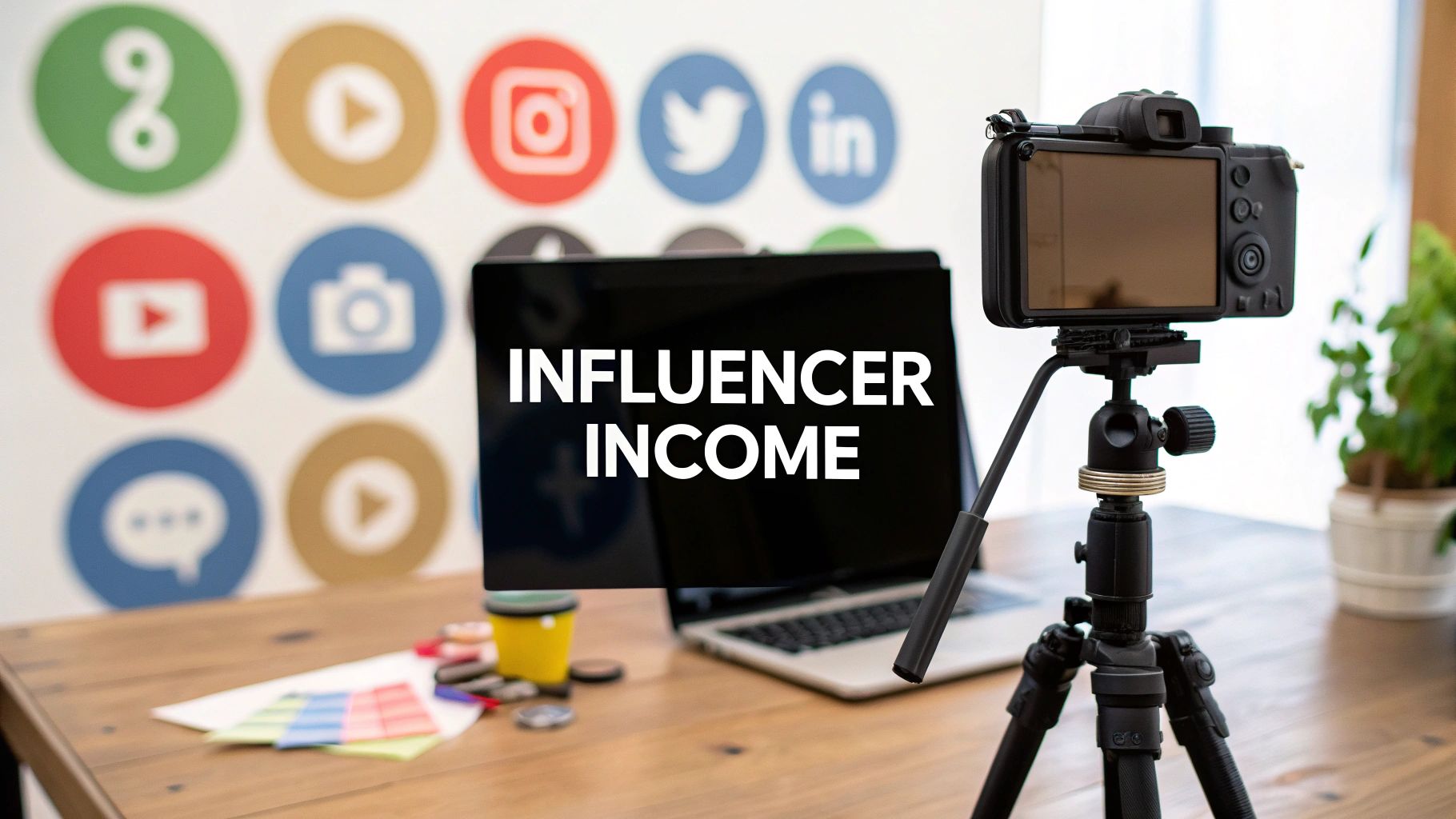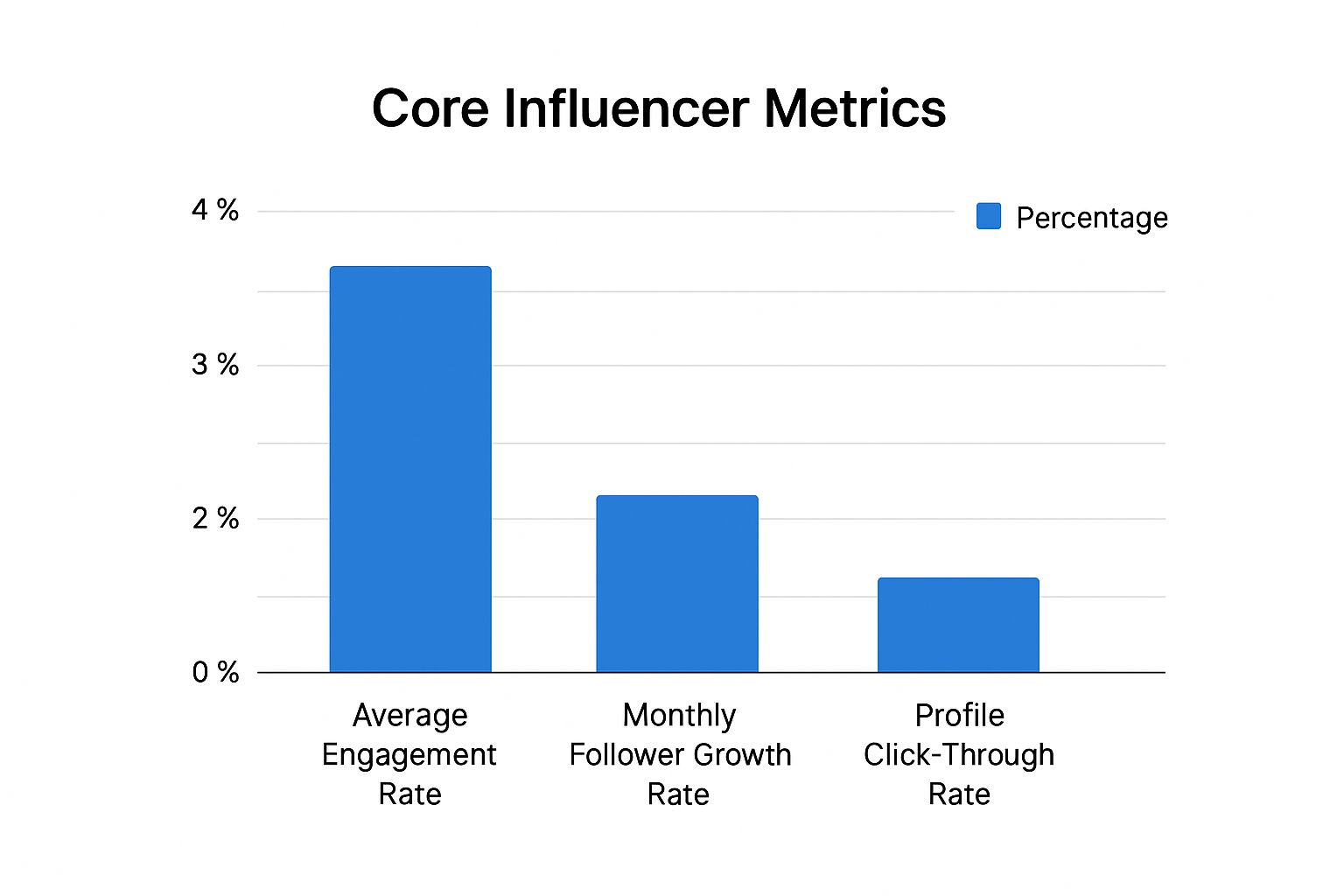How to Make Money as an Influencer
Learn how to make money as an influencer with our guide to brand deals, affiliate marketing, and creator economy business models. Start earning today.

So, you want to turn your influence into income? It's a goal for many, but the path isn't just about racking up followers. Building a real, sustainable business as an influencer means thinking like an entrepreneur and creating multiple streams of revenue. Think brand partnerships, affiliate marketing, selling your own products, and tapping into creator funds from platforms like YouTube and TikTok.
The Reality of Influencer Monetization Today

It’s easy to picture the influencer life as a highlight reel of glamorous photoshoots and endless freebies. While those can be nice perks, the real work happens behind the scenes. It's a strategic operation focused on building a brand that can weather algorithm changes and shifting trends by generating income from several different places.
This isn't some niche hobby anymore; it's a full-blown industry. The global influencer marketing market exploded from just $1.7 billion in 2016 and is on track to hit a staggering $32.55 billion by 2025.
What does that mean for you? It means brands are taking creators seriously. By 2025, a whopping 80% of brands plan to either maintain or increase their influencer budgets. Nearly half of them are set to boost their spending by 11% or more. The money is there, but it flows to creators who treat their platform like a business.
Understanding The Creator Economy
The "creator economy" is just a term for the entire ecosystem of independent creators—from Twitch streamers to Instagrammers—who build businesses around their content. To succeed here, you have to stop thinking of yourself as just a creator and start acting like a business owner. That means truly knowing your audience, delivering consistent value, and being strategic about how you make money.
Your entire monetization journey hinges on the authentic connection you build with your followers. That trust is your most valuable asset, and it's what makes it possible to:
- Promote products you genuinely use and love.
- Sell your own stuff, whether it's a digital guide or a physical product that solves a real problem for your community.
- Offer exclusive content to your most dedicated fans through subscriptions.
The most successful influencers aren't just chasing follower counts; they're building tight-knit communities. Once you provide genuine value to a loyal audience that trusts you, making money becomes a natural next step.
To help you get started, here’s a quick overview of the most common ways influencers are earning a living.
Core Influencer Monetization Methods at a Glance
| Monetization Method | Primary Platform(s) | Effort Level | Income Potential |
|---|---|---|---|
| Sponsored Content | Instagram, YouTube, TikTok | Medium | Medium to High |
| Affiliate Marketing | Blogs, YouTube, Instagram | Low to Medium | Low to High |
| Selling Products/Merch | Any (with e-commerce) | High | Medium to High |
| Subscriptions/Memberships | Patreon, YouTube, Substack | Medium | Low to Medium |
| Ad Revenue/Creator Funds | YouTube, TikTok, Facebook | Low | Low to High |
Each of these paths offers different benefits and requires a unique approach, so it’s smart to start with one or two that align with your content and audience before expanding.
Key Monetization Paths to Consider
Diving into monetization means getting familiar with the specific options out there. For instance, many people get confused by the differences between the Amazon Influencer vs. Affiliate programs. They sound similar, but they're built for different types of creators and content styles. Knowing which one fits your brand is a critical first step.
If you’re just starting and want to build a persona that stands out, tools like those from https://createinfluencers.com/ can help you craft a unique digital identity from the get-go.
Ultimately, the key to long-term success is diversification. Putting all your eggs in one basket—whether it’s one platform or one income source—is a huge risk in this fast-moving space. By exploring different ways to earn, you build a much stronger, more resilient influencer business.
Building a Brand That Attracts Money
Before you can even think about making your first dollar as a creator, you need a brand that acts as a magnet. It has to pull in attention, build trust, and create opportunities. This isn't just fluffy marketing talk; it's the absolute bedrock of your influencer business.
If your brand is weak or confusing, any attempt to make money will fall flat. Brands won't see a clear return on their investment, and your audience won't be inspired to buy what you're recommending.
Think about the most successful creators you follow. They aren't just posting random, unrelated content. They have a distinct point of view, a well-defined niche, and an audience that feels like they get them. That clarity is precisely what makes them so valuable to both followers and brand partners.
Define Your Niche and Audience
The first—and most important—step is to stop trying to be everything to everyone. Vague categories like "lifestyle" are just too broad to make an impact. You have to drill down into a specific area you're genuinely passionate and knowledgeable about. That focus is how you cut through the noise.
Take a creator in the crowded fitness space. Instead of just posting generic workouts, they might specialize in "postpartum fitness for busy moms" or "bodyweight workouts for frequent travelers." See how much clearer that is? It instantly tells potential followers and brands exactly who they are and what they offer.
Once you have your niche, get laser-focused on your ideal audience member. Who are they, really?
- What problems keep them up at night?
- What kind of content would make their day better or easier?
- Where do they spend their time online?
Answering these questions helps you create content that hits home, turning casual viewers into a loyal community. And that engaged community is what brands are willing to pay for. For more on this, our other influencer guides go much deeper into brand building.
Optimize Your Digital Storefront
Your social media profiles are your digital storefronts. They need to look professional and make it obvious what you're about in a matter of seconds. When a brand manager or a potential new follower lands on your page, there should be zero confusion about who you are and what you do.
Here are a few things you can do right now to sharpen up your profiles:
- A Crystal-Clear Bio: State your niche and value proposition right away. Something like, "Helping remote workers create productive and ergonomic home offices."
- A High-Quality Profile Picture: Use a clear, well-lit headshot. Your face builds trust and makes you recognizable. No blurry concert photos!
- A Strategic Link-in-Bio: Don't just drop a single link. Use a simple tool like Linktree or Beacons to house links to your blog, other social channels, and—most importantly—your media kit.
- A Curated Content Feed: Your last 9-12 posts should tell a cohesive story. If you're a travel creator, your feed shouldn't be full of random food pictures unless they're directly related to your travels.
Think of your profile as a business card. It has to make a killer first impression to attract the right kind of attention.
Create a Professional Media Kit
A media kit is your resume as a creator. It’s a document—usually a PDF—that neatly packages your brand story, audience demographics, key performance stats, and collaboration options. Having one ready to go instantly signals to brands that you're a professional who takes this seriously.
But your media kit is more than just a list of follower counts. It’s your chance to tell a compelling story backed by hard data.
A great media kit does more than list your stats. It sells your influence by showcasing your unique value, your connection with your audience, and your past successes. It answers the crucial question: "Why should a brand work with me?"
To build a powerful one, you need to track the metrics that brands actually care about. They're looking for proof of an engaged, active community, not just a massive but passive following.

This kind of data is gold. It shows that a high engagement rate can be far more valuable to a brand than rapid follower growth because it points to a loyal, interactive audience. Tracking and presenting these numbers proves you can drive real results, which is the key to making money in this game.
Mastering Your First Brand Partnerships

When people think about making a living as a creator, brand partnerships are usually the first thing that comes to mind. It's a huge milestone, that moment you shift from making content just for fun to getting paid for your work. But landing those deals takes a lot more than just having a decent following. It demands a professional, strategic game plan.
Forget waiting for brands to slide into your DMs. The real money is in proactively finding the right partners, knowing your worth, and pitching them with confidence. This is where all the time you've spent building a loyal community and a specific niche really starts to pay off.
Finding and Pitching the Right Brands
The best brand deals are the ones that feel completely natural, almost like you’d post about the product anyway. Your audience is smart—they can spot a forced, inauthentic partnership a mile away, and it's a fast way to lose the trust you've worked so hard to earn.
So, where do you start? Make a list of the products and services you already use and genuinely love. Are you a travel creator who swears by a certain brand of packing cubes? They should be at the very top of your list. These are the easiest and most authentic pitches you'll ever make.
Once you have a list of dream brands, it's time for a little detective work. Look for a "press," "media," or "partnerships" email on their website. If you come up empty, a polite search on LinkedIn for a marketing or brand manager often does the trick.
When you reach out, your pitch needs to be more than just, "I love your stuff, let's work together." You need to sell them on the why. Why is your audience their perfect customer? How can you create content that drives real results for them?
Keep your first email short, professional, and packed with value. Introduce yourself, explain your real connection to their brand, and attach a media kit. It’s also a great idea to briefly outline a content idea that shows you’ve actually thought about how you can help them hit their marketing goals.
Setting Your Rates and Understanding Value
One of the biggest hurdles for new creators is figuring out what to charge. It's a tough question, and the answer isn't just about your follower count. Your real value is a combination of several factors.
When you're building out your rate card, you need to think about:
- Engagement Rate: A smaller, highly engaged audience is often way more valuable to a brand than a massive, passive one. Your engagement rate is hard proof of your community's loyalty.
- Content Format: A few quick Instagram Stories take a lot less effort than a fully produced, edited 10-minute YouTube video. Price your work accordingly.
- Usage Rights: If a brand wants to use your content on their own ads or website, that's an extra licensing fee. Don't give it away for free.
- Exclusivity: A brand might ask you not to work with their competitors for a set period. This limits your income potential, so you need to charge more for it.
To give you a starting point, it helps to see what others are charging. Rate cards can vary wildly, but here are some typical ranges based on industry data.
Influencer Rate Card Examples by Platform
| Influencer Tier (Followers) | Instagram Post Rate | TikTok Video Rate | YouTube Integrated Video Rate |
|---|---|---|---|
| Nano (1k-10k) | $10 - $100 | $5 - $25 | $20 - $200 |
| Micro (10k-50k) | $100 - $500 | $25 - $125 | $200 - $1,000 |
| Mid-Tier (50k-500k) | $500 - $5,000 | $125 - $1,250 | $1,000 - $10,000 |
| Macro (500k-1M) | $5,000 - $10,000 | $1,250 - $2,500 | $10,000 - $20,000 |
| Mega (1M+) | $10,000+ | $2,500+ | $20,000+ |
These numbers are just a guide. Don't be afraid to adjust your rates based on your specific niche, engagement, and the scope of the project.
Navigating Contracts and Disclosures
Once a brand says "yes," the work isn't over. This is when the legal and ethical side of things kicks in. You’ll almost always get a contract, and it's absolutely critical that you read every word before signing. Pay close attention to the scope of work, content approval process, payment terms, and those all-important usage rights.
Just as important is being transparent with your audience. The Federal Trade Commission (FTC) has very clear rules that require influencers to disclose sponsored content. This isn't optional—it's the law, and it's the foundation of keeping your audience's trust.
Always use clear, easy-to-see disclosures right at the beginning of your post, such as:
- #ad
- #sponsored
- #BrandPartner
Most platforms also have a built-in "Paid Partnership" tool that makes this even easier. Using these tools and hashtags ensures you’re compliant and, most importantly, honest with your followers.
For a deeper dive on this, you can check out our https://createinfluencers.com/blog for articles on FTC rules and contract negotiation. Getting these foundational pieces right from day one is how you build profitable, long-term relationships with brands you love.
Diversifying Beyond Sponsored Posts

Let's be real: living off sponsored posts alone is a white-knuckle ride. It might feel great when the deals are rolling in, but building a career on a single pillar is a recipe for anxiety. Brand budgets dry up, algorithms pivot overnight, and your audience will eventually tune out if every other post is an #ad.
The secret to a long-lasting, stable career as a creator is to build multiple income streams that you actually control. This is the moment you stop just being a creator and start thinking like a business owner. Diversifying your income isn't just a safety net; it's what builds a resilient financial foundation. Two of the most effective ways to do this are affiliate marketing and selling your own products.
Unlocking Passive Income with Affiliate Marketing
At its core, affiliate marketing is simple: you talk about products or services you genuinely use and love, and you get a commission when someone buys through your unique link. It’s one of the most organic ways for influencers to earn because it’s built on the trust you’ve already established.
What's so powerful about this model is that it's largely passive. A single affiliate link in a high-performing blog post or a YouTube video description can keep earning you money for months, or even years, with no extra effort. The trick is to weave these links into your content so naturally they feel more like a helpful recommendation than a hard sell.
For anyone on visual platforms, mastering Instagram affiliate marketing success is a game-changer, opening up revenue streams far beyond the typical sponsored post.
Choosing the Right Affiliate Programs
Not all affiliate programs are built the same. The real key is to partner with brands that are a perfect fit for your niche and that your audience will actually thank you for recommending. Pushing random products just for a commission is the fastest way to kill the trust you've worked so hard to build.
Here are a few places to get started:
- Amazon Associates: This is the go-to starting point for many. With its massive catalog, you can find just about anything for any niche. The commissions can be on the lower side, but the volume often makes up for it.
- ShareASale & CJ Affiliate: These are huge networks that connect you with thousands of brands, from indie companies to major retailers. You'll often find better commission rates and more support here.
- In-House Programs: Don't forget to check the websites of your favorite tools and brands. Many, especially in the tech and digital space, run their own private affiliate programs. Just look for a "Partners" or "Affiliates" link in their website footer.
The golden rule of affiliate marketing is authenticity. Only recommend products you have personally used, tested, and would genuinely endorse even if you weren't getting paid. Your audience's trust is your most valuable currency.
If you want to go deeper into affiliate strategies and learn how to really maximize your income, check out our guide on building your affiliate marketing presence.
Becoming an Entrepreneur by Selling Your Own Products
While affiliate marketing is a fantastic income stream, the real leap into entrepreneurship comes from creating and selling your own products. This is where you graduate from earning a small percentage to keeping the lion's share of the revenue. It gives you total control and builds a powerful, long-term brand asset.
The idea of selling your own stuff can sound overwhelming, but it doesn’t mean you need to rent a warehouse and deal with shipping logistics. In fact, many of the most successful influencers get their start with digital products, which have almost zero overhead and can be sold an infinite number of times.
Digital vs. Physical Products: What to Create
The perfect product for you is hiding in plain sight—in your audience's needs. The first step is to simply listen. What are the most common questions in your DMs? What problems are your followers always trying to solve? Your next big product idea is probably right there.
Popular Digital Products:
- Ebooks or Guides: Do people always ask you about the same topic? Package your knowledge into a definitive guide.
- Presets: If you're a photographer or travel creator, Lightroom presets are an incredibly popular and easy-to-sell digital good.
- Templates: This could be anything—workout plans for a fitness coach, meal prep guides for a food blogger, or content calendars for a marketing expert.
- Online Courses: For those with a deep, teachable skill, a high-value online course can quickly become a cornerstone of your business.
Popular Physical Products:
- Branded Merch: T-shirts, mugs, and hats with your logo or an inside joke are a classic for a reason. They let your community feel like part of the club.
- Niche-Specific Items: Think bigger than just a logo. A fitness influencer could create their own resistance bands. A home cook could sell a custom spice blend.
Before you go all-in, validate your idea with your audience. Seriously, don't skip this step. Run a poll on Instagram, ask for feedback in your Facebook group, or even try to pre-sell it to see who’s interested. If people are excited, you know you're onto something. Platforms like Gumroad make selling digital products incredibly simple, while Shopify is the gold standard for setting up a store for physical goods.
Advanced Monetization for Established Creators
Once you’ve got a solid foundation with brand deals and affiliate marketing, it's time to start playing a bigger game. The strategies that take you from simply earning a living to building genuine, long-term wealth are a whole different beast. This is where you move beyond sponsored posts and start creating assets you actually own.
For creators who've put in the work, the most logical next step is building a recurring revenue model. This is all about shifting a slice of your audience from being casual viewers to becoming paying members—people who value your work so much they want to support it directly. It’s a game-changer that creates predictable income, shielding you from finicky algorithms and the ups and downs of brand budgets.
Building Your Subscription Community
The idea here is simple: you offer exclusive content or special perks to your most dedicated fans for a small monthly fee. This model is built on community, giving your biggest supporters a place to get more of what they love about your work.
You don't need to build a complicated payment system from scratch, either. Platforms like Patreon, Substack, and even native channel memberships on YouTube make this super accessible. You can just focus on what matters most—creating value that people are genuinely happy to pay for.
So, what kind of content actually makes someone want to open their wallet every month? It has to be something they can't just get for free on your public channels.
- Behind-the-scenes access: Give them a peek behind the curtain. Think bloopers, raw footage, or "director's commentary" style breakdowns of your public videos.
- Exclusive content: This could be anything from a members-only podcast, an extra video each week, or early access to your regular content before anyone else sees it.
- Direct access and community: A private Discord server where you hang out, monthly Q&A sessions, or even personalized feedback on member projects can be incredibly valuable.
- Educational resources: If you're an expert in your field, offer members-only tutorials, workshops, or downloadable guides that help them learn a skill or solve a problem.
A successful membership isn't just about putting content behind a paywall; it's about building a real, thriving community. It’s a two-way street where members feel a much deeper connection to you, and in return, you get the financial stability to keep doing what you do best.
The strongest subscription models are built on a sense of belonging. Members aren't just buying content; they're investing in a community and a creator they believe in. Make them feel like true insiders.
Expanding into High-Value Opportunities
Beyond subscriptions, your influence and expertise open up some seriously lucrative doors. These avenues turn your personal brand into a stamp of authority, letting you charge premium rates for your time and knowledge. This is the moment you transition from being a content creator to being seen as a respected expert in your niche.
Think about it—what unique skills have you picked up while building your audience? Are you a wizard at video editing? An undisputed expert in your topic? A natural in front of a crowd? Each of those skills can be turned into a high-ticket revenue stream.
Leveraging Your Expertise Beyond Content
Once your name carries some real weight in your industry, you can start exploring these more advanced income channels. They all require a slightly different approach, but each one can dramatically boost your bottom line.
High-Impact Monetization Channels:
| Monetization Strategy | Description | Who It's For |
|---|---|---|
| Consulting Services | Offer one-on-one coaching or strategic advice to individuals or brands who want to learn from your success in a specific niche. | Creators with deep, proven expertise in something specific (e.g., SEO, social media growth, video production). |
| Paid Speaking Gigs | Get paid to speak at industry conferences, corporate events, or workshops. Your status makes you a compelling draw for organizers. | Charismatic creators who are comfortable on a stage and can deliver an engaging, insightful presentation. |
| Content Licensing | Sell the rights to your viral videos or high-quality photos to media outlets, ad agencies, or brands to use in their own campaigns. | Creators who produce highly shareable, top-notch visual content that has broad appeal. |
| Paid Newsletters | Use a platform like Substack to create a premium newsletter that delivers exclusive insights or analysis right to your subscribers' inboxes. | Writers and subject-matter experts who can consistently deliver high-value written content people will pay for. |
These strategies are really the final piece of the puzzle for a diversified influencer business. They don’t just bring in significant income; they also cement your reputation as a leader in your space. When you thoughtfully combine subscriptions with these high-value services, you create a truly robust business that can thrive for years.
Common Questions About Influencer Income
Jumping into the world of making money as an influencer always brings up a ton of questions. The path isn't always a straight line, and it’s way too easy to get sidetracked by myths and bad advice. Let's clear the air and tackle some of the most common things aspiring creators get stuck on.
How Many Followers Do I Really Need to Make Money?
This is the question I hear more than any other, and the answer usually surprises people: it’s not about the number of followers you have, but the quality of the connection you have with them.
The old days of needing 100,000+ followers to even think about landing a brand deal are long gone. Brands have gotten smarter. They’re now pouring their budgets into micro-influencers (usually in the 10k-50k follower range) and even nano-influencers (1k-10k followers). Why? Because these smaller accounts often have incredibly engaged, niche communities that actually listen.
Think about it: a creator with 5,000 loyal followers who trust every recommendation they make will almost always drive more sales than a creator with 500,000 passive scrollers. Brands look at things like the quality of your comments, how many people share your posts, and your story replies—not just a vanity metric.
Your ability to earn is tied directly to the trust you've built with your audience, not its size. Focus on building that loyal community first, and the money will follow.
What Are the Biggest Mistakes New Creators Make with Monetization?
When those first opportunities start rolling in, it's exciting! It's also really easy to fall into a few common traps that can seriously slow down your growth. Knowing what these are from the get-go is half the battle.
Here are a few of the most frequent missteps I see:
- Undervaluing Your Work: Look, accepting free products for a post is totally fine when you're just starting. But creating good content takes real time and effort. Once you have proof that your audience is engaged, don't be afraid to set a fair rate for your work.
- Not Having a Media Kit: Pitching brands without a professional media kit is like showing up to a job interview in your pajamas. It immediately signals that you're an amateur. A sharp, one-page media kit with your stats, who you are, and what you offer is non-negotiable.
- Saying Yes to Everything: It’s so tempting to take any deal that comes your way, especially at first. But partnering with brands that don’t actually fit your niche or your values is the fastest way to lose your audience’s trust. Be picky. Authenticity is your most valuable asset.
How Do I Handle Taxes as an Influencer?
The moment you start earning money, you become a business owner in the eyes of the IRS. And that means you have to deal with taxes. Ignoring this part is a recipe for a massive headache down the road.
The most important thing to do is start tracking everything from day one.
You're basically self-employed, which means no one is withholding taxes from your paychecks for you. A good rule of thumb is to take 25-30% of everything you earn and stash it in a separate bank account just for your tax bill. Don't touch it.
Also, get into the habit of tracking your business expenses. Things like a new camera, software subscriptions, props for a shoot, and even part of your internet bill can often be written off, which lowers how much you'll owe. When in doubt, seriously consider talking to a tax professional who works with freelancers or creators. It’s worth every penny.
Should I Join an Influencer Marketing Agency?
As you start to grow, you might think about getting an agent or joining an influencer marketing agency. They can be a huge help by finding and negotiating brand deals for you, which saves a ton of time. But it's not the right move for everyone.
Let's break it down.
Pros of Joining an Agency:
- Access to Bigger Brands: Agencies have connections. They can get you in the door with major brands you might not be able to reach on your own.
- Better Negotiation Power: These people are pros at negotiating higher rates and better contract terms. They know what you're worth.
- It Frees Up Your Time: They handle all the back-and-forth emails and admin work, so you can focus on what you're good at: creating content.
Cons of Joining an Agency:
- They Take a Cut: Nothing is free. Agencies will typically take a commission of 15-20% of your earnings from the deals they land for you.
- You Lose Some Control: You might have less direct contact with the brands you're working with, as the agency acts as the middleman.
- Exclusivity Clauses: Read the fine print. Some contracts will prevent you from finding your own brand deals on the side.
For most creators, it makes sense to wait until you're earning consistently and feel totally swamped by the business side of things before you start looking for representation.
Ready to create your own unique digital identity? CreateInfluencers allows you to generate lifelike AI avatars and stunning visual content in minutes, giving you the tools to build a standout brand from scratch. Start creating for free at https://createinfluencers.com.